
Special Report : USS Eisenhower
Giampaolo Tonello visited the USS Eisenhower aircraft carrier in May 2009 during its deployment.
Eisenhower Carrier Strike Group 2009 Deployment
Commanded by Rear Admiral. Kurt W. Tidd, the Carrier Strike Group 8 departed on February 21 for the scheduled rotational deployment. In addition to the USS Dwight D. Eisenhower and its embarked air wing, Carrier Air Wing (CVW) 7, the Eisenhower Carrier Strike Group also consisted of Destroyer Squadron 28 with its assigned ships USS Bainbridge (DDG 96) and USS Halyburton (FFG 40); the fast attack submarine USS Scranton (SSN 576); and the Mayport, Florida-based ships USS Vicksburg (CG 69) and USS Gettysburg (CG 64). The Carrier Strike Group counted nearly 5,800 Sailors. Relieving the Theodore Roosevelt CSG, the Eisenhower CSG as Commander Task Force (CTF) 50 deployed for five months. The Task Force supports Operation Enduring Freedom (OEF) and maritime security and coalition operations in the 5th Fleet and 6th Fleet Areas of Responsibility, which included Operations Iraqi Freedom and anti-piracy operations during 2009.
During the deployment, embarked Carrier Air Wing (CVW) 7 conducted more than 4,600 flight sorties totaling more than 16,000 hours with a 99% sortie completion rate. Of those sorties, 2,010 were combat sorties supporting U.S. and Coalition forces in Afghanistan.
The Eisenhower Carrier Strike Group was relieved by the Ronald Reagan CSG on July 6, 2009. The Ike arrived back home at Norfolk Naval Station on July 30 with the CVW 7 squadrons returning earlier in the week to their home stations. "I could not be more proud of the men and women embarked on Dwight D. Eisenhower as part of the Eisenhower CSG. They have performed magnificently this entire deployment," said Capt. Dee L. Mewbourne, commanding officer USS Dwight D. Eisenhower in the Navy press release. "Safely operating both in the air and on the sea over the past five months, often in arduous conditions, they supported coalition forces on the ground in Afghanistan with utmost professionalism while providing regional security and stability. Without question, their service made a difference."
The Eisenhower Carrier Strike Group departed on January 2, 2010, for another scheduled 6-month deployment to support the troops on the ground in Afghanistan and execute Maritime Security Operations in the 5th and 6th Fleet Area of Responsibility again.
Visiting the USS Eisenhower Aircraft Carrier
We visited the USS Dwight D. Eisenhower during her 2009 deployment. Visiting the carrier in the Sea of Pakistan, also means we had to make a long flight with the fascinating C-2A Greyhound. Backbone of air transport and liaison with aircraft carriers, the aircraft is better known by its acronym "COD" (Carrier Onboard Delivery). Backwards, gloom, hot temperature and deafening noise: certainly not a first class flight, but after the excellent 3 hour flight the old COD served us with a fantastic Trap! And when it lowered its aft cargo ramp door…... the Mighty Ike, as the carrier is called, was there to embrace us with its noisy, busy, colorful and to us confusing deck!
Carrier Air Wing 7
Carrier Air Wing 7 consisted 8 Squadrons counting 61 aircraft during the 2009 deployment. Capt. Calvin Craig was the Commander, Carrier Air Wing, and Capt. Roy Kelley, Deputy Commander. Positions that are still referred to as "CAG" and "DCAG" from when the Carrier Air Wing was called Carrier Air Group.
Carrier Airborne Early Warning Squadron (VAW) 121 "Blue Tails" flies four E-2C Hawkeye 2000 aircraft for AEW (Airborne Early Warning) and ABCC (Airborne Command and Control) using the rotating AN/APS-145 radar, SATCOM and datalink (4,11,16) capabilities. US Navy Hawkeye 2000 aircraft were fitted with digitally controlled, eight-bladed NP2000 propellers from 2004 onwards, and a new mission computer from 2005 onwards. The E-2C will be replaced by the E-2D Advanced Hawkeye starting in 2011.
Strike Fighter Squadron (VFA) 103 "Jolly Rogers" flies twelve F/A-18F Super Hornets, with the rear seat occupied by a Weapons Systems Officer. Strike Fighter Squadron (VFA) 143 "Pukin' Dogs" flies twelve F/A-18E Super Hornet single seaters. The Super Hornet carries out strike/fighter missions, maritime/overland ISR, and can be used as airborne tanker. Super Hornets are equipped with Link 16 and the Joint Helmet mounted Cueing system (JHMCS), as well as the ATFLIR targeting pod, and SHARP reconnaissance pod. Recent addition to the wide variety of air-to-air and air-to-ground weapons include JSOW, JDAM and Laser JDAM.
Strike Fighter Squadron (VFA) 131 "Wildcats" and Strike Fighter Squadron (VFA) 83 "Rampagers," flying ten F/A-18C Hornets each. The F/A-18C carries out strike/fighter missions and maritime/overland ISR having received new weapons and integration of ATFLIR, Link 16 and Joint Helmet mounted Cueing system (JHMCS). Replacement of the 'legacy' Hornets is scheduled to begin in 2015, with either Super Hornets or F-35C Lightning II subject to funding, schedule and allocation decisions.
Electronic Attack (VAQ) Squadron 140 "Patriots," flying four EA-6B Prowler electronic warfare aircraft. The old Prowler provides SEAD (Suppression of Enemy Air Defense) and EW capabilities with its ALQ-99 jamming pods and the ability to use AGM-88 HARM. Nowadays it also carries out maritime and overland ISR, having received the ICAP III upgrade. ICAP III provided the aircraft with MIDS/Link 16 and "blue force" tracking while updating its threat emitter geo-locator and selective reactive jamming capability. The last EA-6Bs are to be retired by 2013 and will be replaced by the new EA-18G Growler.
Helicopter Anti-Submarine (HS) Squadron 5 "Nightdippers," flying four SH-60F and three HH-60H Seahawk helicopters. The SH-60F equipped with dipping sonar, sonobuoys, torpedoes, and machine guns and the HH-60H with FLIR, Hellfire missiles, and machine guns conduct various missions, including ASW (Anti Submarine Warfare), CSAR (Combat Search And Rescue), ASUW (Anti Surface Warfare) and NSW (Naval Special Warfare). By 2015, all SH-60/HH-60 will be replaced by the MH-60S and MH-60R flown by newly formed HSC (Helicopter Sea Combat) and HSM (Helicopter Maritime Strike) squadrons respectively, replacing both the embarked Helicopter Anti-Submarine and the Helicopter Anti-Submarine Light (HSL) detachments to other ships for each group.
Fleet Logistics Support Squadron (VRC) 40 "Rawhides" flying two C-2A Greyhounds, simply called "COD" (the acronym for Carrier Onboard Delivery), providing Liaison and transport to and from the carrier. The original C-2A aircraft were phased out in 1987 and replaced by new reprocured C-2As with airframe and avionic improvements. These aircraft are now undergoing a Service Life Extension Program (SLEP) to increase the operating service life, which will also replace the four bladed propellers with the digitally controlled, all-composite, eight-bladed NP2000 propeller.
| Carrier Air Wing 7 (CVW 7) | ||||
| Unit | Aircraft Type | Qty | Mission | |
| Strike Fighter Squadrons | VFA-103 Jolly Rogers | F/A-18E/F Super Hornet | 12 | strike/fighter missions, maritime/ overland ISR, and airborne tanker |
| VFA-143 Pukin’ Dogs | F/A-18E/F Super Hornet | 12 | strike/fighter missions, maritime/ overland ISR, and airborne tanker | |
| VFA-131 Wildcats | F/A-18C Hornet | 10 | Strike/fighter missions and maritime/overland ISR | |
| VFA-83 Rampagers | F/A-18C Hornet | 10 | Strike/fighter missions and maritime/overland ISR | |
| Carrier Airborne Early Warning Squadron | VAW-121 Blue Tails | E-2C Hawkeye | 4 | AEW (Airborne Early Worning) and ABCC (Airborne Command and Control) |
| Electronic Attack Squadron | VAQ-140 Patriots | EA-6B Prowler | 4 | SEAD (Suppression of Enemy Air Defense) capabilities and maritime/overland ISR |
| Helicopter Anti-submarine | HS-5 Nightdippers | SH-60F Seahawk | 4 | ASW (Anti Submarine Warfare), CSAR (Combat Search And Rescue), ASUW (Anti Surface Warfare) and NSW (Naval Special Warfare). |
| HH-60H Seahawk | 3 | ASW (Anti Submarine Warfare), CSAR (Combat Search And Rescue), ASUW (Anti Surface Warfare) and NSW (Naval Special Warfare). | ||
| Fleet Logistics Support Squadron | VRC-40 Rawhides | C-2A Greyhound | 2 | “COD” (Carrier Onboard Delivery) |
Ike's History
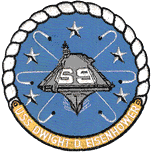
The USS Dwight D. Eisenhower (CVN 69) is the third nuclear-powered aircraft carrier and the second of 10 Nimitz-class aircraft carriers built. Named after the nation's 34th president, the USS Dwight D. Eisenhower was christened on October 11, 1975, by Mrs. Mamie Doud-Eisenhower, the ship's sponsor and widow of the late president. The Eisenhower was commissioned on October 18, 1977, and assigned to the U.S. Atlantic Fleet. After 14 months of fleet training, Ike set sail for her first deployment.
Ike completed four deployments, before returning in October 1985 to the Newport News shipyard for a 18-month overhaul, including the addition of the Close-in Weapons System, Sea Sparrow Missile System, and various system upgrades and compartment refurbishment. Ike re-joined the fleet in April 1987.
In 1990, the Ike was on deployment to the Mediterranean Sea when Iraq invaded Kuwait. The Eisenhower sailed through the Suez Canal to the Red Sea in a measure to protect Saudi Arabia and supported Maritime Interception Operations to enforce the U.N. embargo imposed on Iraq. Returning home for an extensive shipyard and training period, Ike did not take part in Operation Desert Storm. But the carrier deployed on September 26, 1991 to the Arabian Gulf to support continuing missions of post-hostilities Operation Desert Storm. Ike returned to Norfolk on April 2, 1992. On January 6, 1993, IKE entered Norfolk Naval Shipyard for overhaul and conversion, and returned to the fleet on November 12, 1993.
In September 1994, IKE headed for Port-au-Prince to spearhead Operation Uphold Democracy, the U.S.-led effort to restore the democratically elected government of Haiti. In a historical first, the U.S. Army 10th Mountain Division embarked for the operation, proving the concept of "adaptive force packaging". In October 1994, IKE sailed on for a six-month deployment which included flying missions in support of Operations Southern Watch and Deny Flight. The carrier returned to Newport News shipyard on July 17, 1995, for an 18-month complex overhaul which was completed on January 27, 1997. The carrier continued on-going rotation deployments, supporting Operation Southern Watch and finally concluding with its "Millennium Cruise" to the Mediterranean Sea and Arabian Gulf.
On May 24, 2001, IKE entered the Northrop Grumman Newport News (NGNN) shipyard to undergo Refueling Complex Overhaul (RCOH). The four-year, approximately $2.5 billion dollar mid-life overhaul prepared the ship for another 25 years of service. The RCOH included the reconstruction of the ship's island, the installation of a new antenna mast, the installation of a new radar tower, an upgrade and modernization of combat and communication systems, overhaul of the ship's hull, mechanical and electrical systems, and the refueling of her two nuclear reactors. Also one Sea Sparrow launcer and all three 20mm Phalanx CIWS mounts were replaced by two Mk 51 Rolling Airframe Missile (RAM) systems. Augmenting the work by the shipyard's worker and contractors, the crew logged more than 5.9 million man-hours in support of the RCOH.
After spending almost four years at NGNN, IKE returned to her homeport at Naval Station Norfolk, Virginia, on January 25, 2005. 3,300 Sailors and more than 490 NGNN shipyard and Naval Sea System Command employees and contractors embarked for its Sea Trials. After successful completion of the trials, Ike was redelivered to the fleet on March 25, 2005. Next, Ike completed flight deck certification on April 5, 2005, followed by a four-month Post Shakedown Availability and Selected Restricted Availability program, which was completed in October 2005. Carrier Air Wing Seven returned to the ship in February 2006 to start the Fleet Readiness Training Plan.
On October 3, 2006, IKE deployed for the first time since 2000. The Eisenhower CSG supported operations in Iraq and Afghanistan, and conducted maritime security operations (MSO) in the U.S. 5th Fleet area of responsibility (AOR). CVW-7 began flying combat missions from the North Arabian Sea into Afghanistan in support of Operation Enduring Freedom (OEF) and the International Security Assistance Force (ISAF) on November 6. Over the next six months, the Eisenhower CSG transited repeatedly between the North Arabian Sea and the Persian Gulf to support the troops in Operation Iraqi Freedom (OIF) as well.
Assuming command on November 16, 2007, Captain Dee L. Mewbourne became the 14th Commanding Officer of the CVN 69.
| USS Dwight D. Eisenhower (CVN 69) | ||||
| Carrier Class | Nimitz class | |||
| Builder | Newport News Shipbuilding Co. (today - Northrop Grumman Shipbuilding) | |||
| History | ||||
| Keel laid | Aug. 15, 1970 | |||
| Launched | Oct. 11, 1975 | |||
| Commissioned | Oct. 18, 1977 | |||
| Refueling Complex Overhaul (RCOH) | 2001 - 2005 | |||
| Organisation | ||||
| Command | Commander Naval Air Force, U.S. Atlantic Fleet (COMNAVAIRLANT) | |||
| Carrier Strike Group | Carrier Strike Group Eight (CSG 8) IKE Carrier Strike Group Eight (IKE CSG / IKESTRGRU) | |||
| Commander CSG | Rear Adm. Kurt W. Tidd (2009) Rear Adm. Phil Davidson (2010) | |||
| IKE Commanding Officer | Capt. Dee L. Mewbourne | |||
| Carrier Air Wing | Carrier Air Wing Seven (CVW 7) | |||
| Commander Carrier Air Wing | Capt. Calvin H. Craig (2009) Capt. Roy J. Kelley (2010) | |||
| Home Port | Norfolk Naval Station (NNS), Norfolk, VA. | |||
| Dimensions | ||||
| Length | 1,092 ft (332.85 m) | |||
| Beam | 134 ft (40.84 m) | |||
| Flight Deck Width | 252 ft (76.81 m) | |||
| Height keel to mast | 244 ft (74.37 m) | |||
| Area of flight deck | 4.5 acres (196,020 square ft. / 18,210 m2) | |||
| Properties | ||||
| Propulsion | Two nuclear reactors, four shafts | |||
| Displacement | Approximately 95,000 tons up to 97,000 tons (88,000 metric tons) full load | |||
| Speed | 30+ knots (34.5+ miles per hour) | |||
| Crew | Ship's Company: 3,200 - Air Wing: 2,480 | |||
| Armament | 2x NATO Sea Sparrow launchers, 2x Mk 51 RAM launchers | |||
| Aircraft | ||||
| Max Capacity | 85 aircraft | |||
| Embarked Aircraft | approximately 60 aircraft | |||
| Aircraft Catapults | 4 | |||
| Aircraft Elevators | 4 (3,880 sq. ft.) | |||
Report by Niels Hillebrand and Giampaolo Tonello
Photos from onboard the carrier by Giampaolo Tonello ( view portfolio )
Photos of complete carrier from navy.mil, courtesy U.S. Navy.
Information from eisenhower.navy.mil and navy.mil
Last Revised: -
Last Modified: -

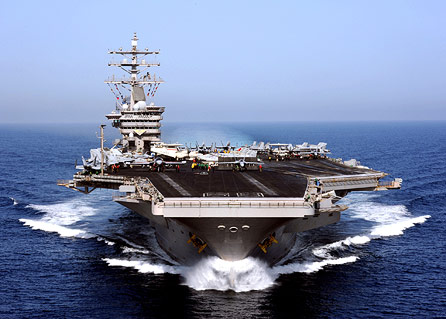
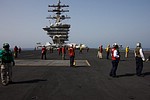
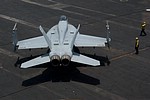
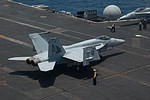
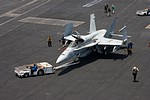
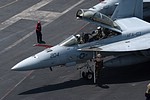
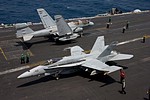
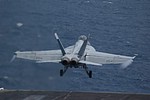
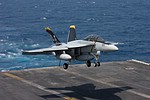
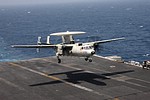
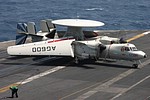
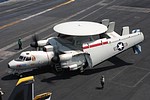
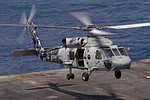
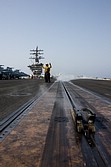
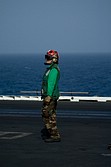
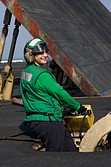
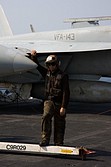
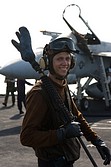
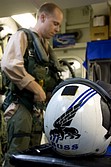
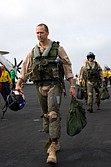
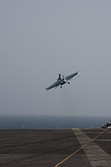
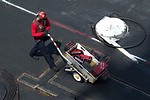
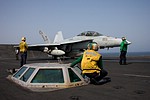
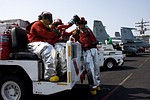
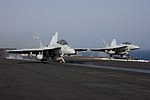
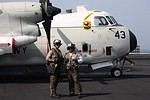
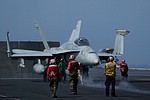
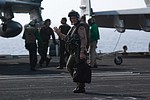
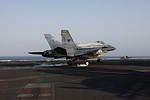
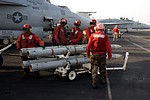
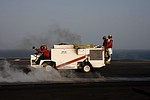
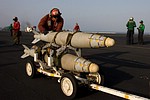
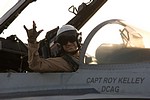
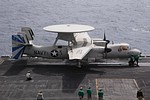
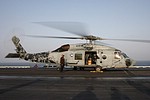
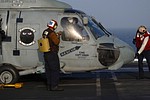
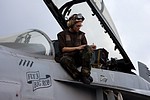
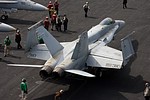
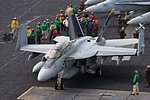
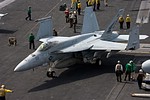
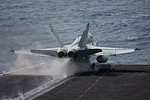
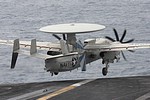
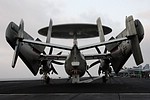
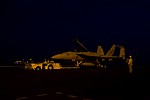
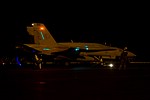
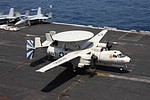
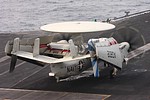
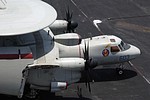
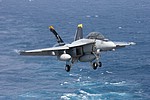
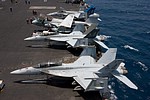
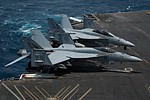
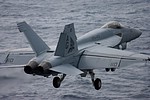
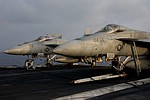
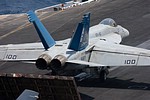
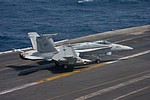
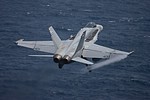
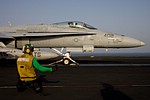
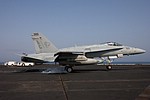
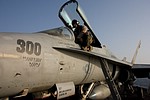
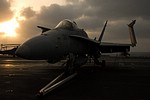
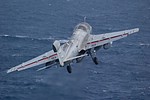
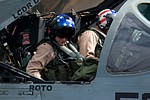
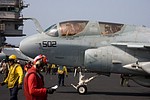
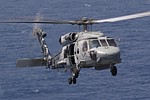
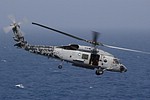
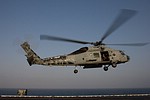
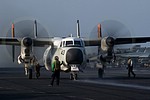
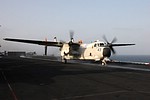
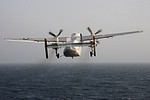
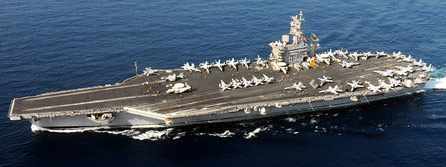
 Back to Index
Back to Index